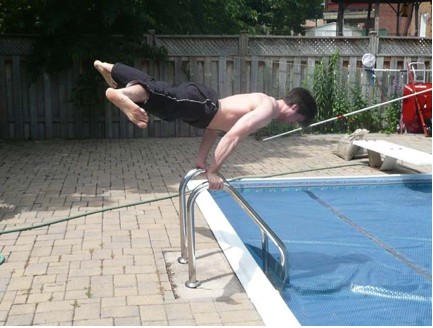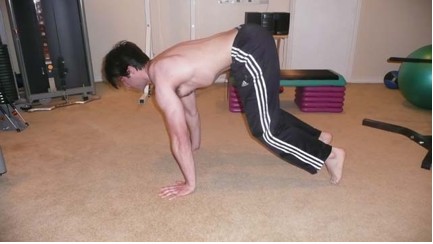Planche Training: Strengthening the Mind/Body Connection
Phil Jelinowski, CSCS
February 3, 2009 10:22 AM
Have you been training the planche progression but are not getting anywhere fast? Wouldn't it be nice to go from tuck planche to straddle planche in just under 4 months? Well I've been there and have done that and now I want to share my knowledge so you can do the same.
When I first started planche training progress was painfully slow. So I became frustrated and quit a number of times. It was not until I realized a few things that progress really picked up and I was on my way to achieving one of my long term goals: to hold a straddle planche.

The first point to take home is that planche is a full body compound exercise; and for any compound exercise muscle synergism is of the utmost importance because you're only as strong as your weakest link. All the involved muscles have to work in perfect harmony otherwise force production will be compromised. This brings us to the mind/body connection. You will not get anywhere if you do the exercises passively not focusing on which muscles are working and if you are not trying to consciously maximize that contraction. A good example to demonstrate this point is an inexperienced person trying to bench press something for the first time. They will life down flat on the bench and try to push the bar with their arms. However if that person were to squeeze the shoulder blades together, arch the lower back, push down through the feet and focus on maximizing the contraction in the chest and shoulders they would be able to produce a greater amount of force due to increased scapular stability and activation of more agonists. The point is that any compound exercise requires conscious effort in order to be performed effectively.
For any compound exercise some muscles act as stabilizers and some as agonists. The stabilizers provide a framework or foundation on which the agonists can produce force. For the planche the agonists are primarily the deltoids and pectorals because all the torque is produced at the shoulder joint and these muscles act to counteract that force. The stabilizers make up the bulk of the muscles active in the planche and the primary ones are the trapezius, latissimus dorsi and teres major.
This brings us to exercise technique. In order to effectively hold the planche at any level of progression you must first activate the stabilizers. To do this plant your hands on the ground or grasp a set of paralletes, slightly protract the shoulder blades, then contract your upper traps as hard as you possibly can (you can see my traps protruding in the above picture). Then begin transferring your weight onto your arms by leaning forward; as you do this contract your lats. As your feet come off the ground contract the agonists.
Looking back at the bench press example retracting the shoulder blades prevents them from moving during the exercise and anchors them to the bench giving you more stability which equals greater force production. The bench press is an open chain exercise performed in the supine position. Whereas the planche is the closed chain exercise performed in the prone position; therefore it makes sense to slightly protract the shoulder blades and contract the upper traps to immobilize them thus giving you scapular stability.
A good exercise to help you recruit those stabilizers and maximize that contraction is a repetitive movement of rocking back and forth as you are in the beginning position with your legs bent and feet in contact with the ground. I do 3 x 8 of this exercise to warm up and prime those stabilizers before holding the planche at a higher level of progression.
 Just rock back and forth in this position and concentrate on contracting your upper traps.
Just rock back and forth in this position and concentrate on contracting your upper traps.One area that I and others have found to be under-stimulated is the chest. I have found that in order to get those sternal pecs working you have to squeeze your arms together while you are holding the exercise (this works best when doing the planche on the floor or on a fixed set of paralletes). Just imagine holding a balloon with your arms extended, palms facing each other and trying to crush it. One final point on technique is the amount of forward lean. Bio-mechanically speaking, leaning forward produces less torque in the shoulder joint because it shortens the moment arm of the applied force thus giving you a greater mechanical advantage. Therefore try to maximize forward lean without falling forward.
In order to make rapid progress when training for the planche you must achieve total muscle synergism. To do this the nervous system has to be efficient at recruiting the right muscles, in the right order at the required intensity. The planche requires balance, coordination and posture control (not to mention an insane amount of strength): it is more than just a strength exercise, it is a motor skill. As with any motor skill progress will be heavily dependent on adaptations in the central nervous system. Due to the demands planche training places on the CNS it is best to use Pavel's 'Greasing the Groove' method (see
The Naked Warrior) when you first start training at any level of the progression. You will keep your nervous system fresh and the repetitive nature will reinforce the motor program. As your nervous system adapts and you are able to hold the progression for a longer period of time only then it is best to use the sets x reps method and maximize time under tension so that your muscles adapt and hypertrophy.
As you advance further into the planche progression any additional force you can produce will make a substantial difference and accelerate your progress. Planche training is like squeezing that last bit of toothpaste out of the tube, but in this case you are trying to squeeze force out of your body anywhere you can. And when it comes to exercise technique and force production I have learned that a little goes a long way. For example, studies have shown that force production is significantly higher when using an alternated grip for the deadlift compared to using a standard pronated grip. Another example is using a fatter bar for the bench press compared to using a thinner bar. So do what works best for you- it could be a wider or narrower arm position, more focus on contracting a specific muscle or using different hand position (i.e try doing the planche off a ledge).
The main point about planche training is that you have to recruit the right muscles in the right order at the right intensity. The goal is to get all those muscles working together in perfect harmony - to achieve complete muscle synergism. In order to do this you have to become aware of your body and make a conscious effort. In summary you have to strengthen the mind/body connection.
Phil Jelinowski, CSCS is a strength coach and personal trainer with a passion for bodyweight strength training and conditioning. He owns and operates a small personal training business Elite Strength & Conditioning in Mississauga, Ontario where he provides fitness services for clients with diverse needs ranging from weight loss to post rehab conditioning. You can contact him at phil.jelinowski@rogers.com or check out his website www.elitesnc.com
Back